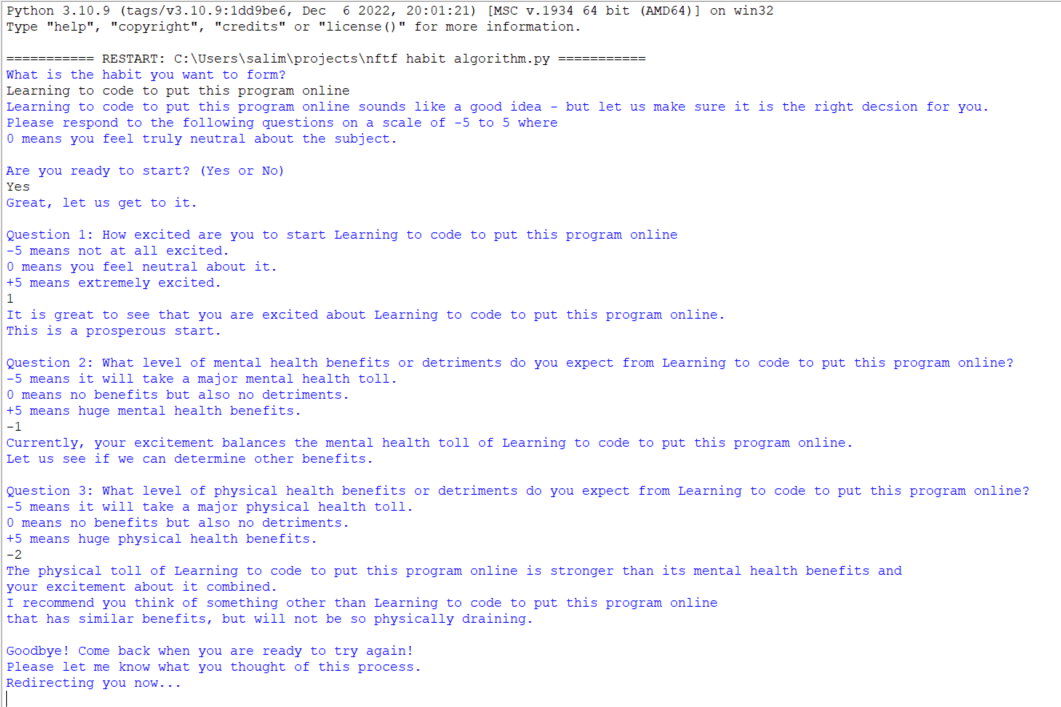Want to start a new habit? Use this tool to check if it’s really worth it!
January is a ripe time for wanting to start a new habit, but is it always worth it? I developed the tool below where you answer a few short prompts using the Negative Five to Five (NFTF) scale to answer that very question.
There is a backstory to how I ended up using Jotform to create this, since I originally developed it on Python (file here), on which I elaborate further down on this page.
The Backstory
A couple weeks ago, I started a course on Udemy called Automate the Boring Stuff (with the free ebook here). This is essentially a course on python.
I was pleasantly surprised that it is quite similar to R, which I used frequently while I was doing my Masters in Statistics. I have been playing around and learning the syntax by testing out gambling strategies (perhaps for another blog post) and then by creating this decision making tool about habits.
Essentially, the python program I created runs like a mini text-based game – where the program asks you a series of questions and uses conditional logic and ongoing calculations to determine whether a habit is worth taking on or not. The questions about the habit are ordered by how important I think each factor is – that is:
1. Excitement
2. Mental Health
3. Physical Health
4. Financial Impact
5. Time Impact
The user is meant to rate each factor on the NFTF scale and the running total is calculated. If the total ever dips below 0 – then the user is recommended to find a more beneficial habit than the one they are currently considering.
The python program took a couple of hours to put together – since I added in a couple of bells and whistles, like redirecting the user to other parts of my website and creating customized responses to questions so that the user can feel heard throughout the experience.
The problem happened when I decided it was time to share my python code.
What I did not know previously is that this is something incredibly difficult to do. For reasons, I barely understand, most front-end web development requires competencies in HTML, Javascript and CSS – and workarounds such as Brython, Flask and NiceGUI all require additional deep learning and have their own limitations. (FYI – chatgpt was not at all helpful either!)
I spent most of the week banging my head against a wall trying to figure this out – especially since I knew that the functionality that mirrored (and even elevated) the python program experience exists in Typeform. But if you think I’m willing to spend $25/month for an account to host this tool…well, you don’t know me very well.
I was stuck trying to decide whether to just do a deep dive or learn Javascript or something until I realized… I made the very tool that could help me! So I booted up the python program and ran through the exercise.
My interaction with the Python program.
Essentially, I was:
+1 Excited, expected a -1 Mental Health toll (because it is so frustrating) and a -2 Physical Health toll (since it would make me sit around all day as I try to work through it)
The total impact was: -2
So, this was not a good idea!
However, when I was first googling Typeform, Jotform’s investment in Google Ad Words paid off. Advertised as a free Typeform alternative, I knew I had to check it out.
Building the tool was a lot clunkier than writing it out in Python, but at least I could style it with my site colors. After a lot of testing, I think I got it! Please do test it out and let me know what you think.
